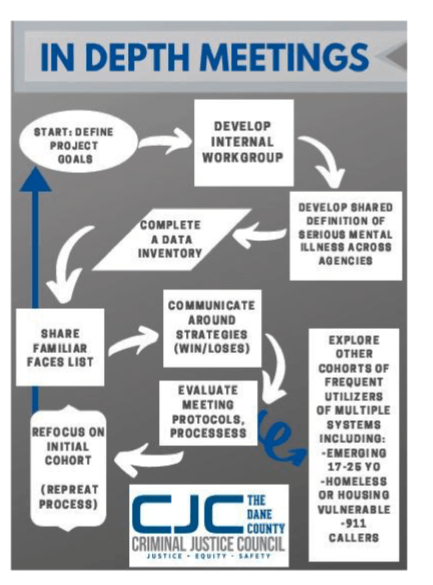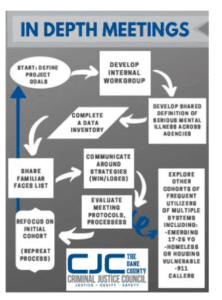A.k.a. “frequent flyers” . . . people with mental illness and substance abuse issues that are in and out of jail on a regular basis. (335 people with more than 10 stays in 3 years) What does the Criminal Justice Council think should be done?
Here’s a report. I’ve seen this on many agendas with no attachments. The geek in me is very excited to see something of substance! Below are a few highlights. If you are interested in making your voices heard, the Criminal Justice Council – Behavioral Health Subcommittee is meeting on Wednesday at . . . well . . . at 10am.
A BIT OF BACKGROUND
In 2016, the Dane County Criminal Justice Council joined President Obama’s Data-Driven Justice Initiative (DDJ). DDJ started as a network of over 60 city, county and state governments committed to using data driven strategies to: divert low-level offenders with mental illness out the criminal justice system, change approaches to pretrial incarceration—and overall—share data across systems. The goal was to better stabilize individuals and families, better serve communities, and reduce criminal justice involvement and duplication. Now, Data-Driven Justice is embedded within the National Association of Counties (https://www.naco.org/resources/signature-projects/data-driven-justice) and Dane County remains an active member.
WORKGROUP
The Dane County Data-Driven Justice-Familiar Faces (DDJ-F2) 1workgroup is comprised of staff from the Dane County Sheriff’s Office, Madison Police Department, Dane County Human Services, Wellpath (medical provider within the jail), Wisconsin Department of Corrections and the CJC Research and Innovation team. This team was grounded in work completed by the Criminal Justice Council—especially the Sequential Intercept Model (SIM) exercise.
PROJECT GOALS
The initial project goal is to use data to drive practice, through ongoing, intentional discussion among the workgroup and other key stakeholders and provide better services in order to break the cycle of incarceration for individuals of Dane County who are experiencing serious mental illness and substance use issues.
- Defining serious mental illness
Defining serious mental illness across agency lines was a key first step. The workgroup agreed to use the following definition, which is a modification to a definition from The Substance Abuse and Mental Health Services Administration (SAMHSA)3:
Refers to individuals 18 or older, who currently or at any time during the past year have had a diagnosable mental, behavioral, or emotional disorder of sufficient duration to meet diagnostic criteria specified in the current diagnostic manual of the APA and that has resulted in functional impairment, that substantially interferes with or limits one or more major life activities. Serious mental illnesses include mood disorders such as major depressive disorder and bipolar disorder, and major psychotic disorders such as schizophrenia and schizoaffective disorder, and other mental disorders that cause serious impairment. Note: Impairment resulting from a primary diagnosis of substance use disorder does not qualify a person as having a serious mental illness. Major life activities include basic living skills (e.g. eating, bathing, dressing); instrumental living skills (e.g. maintaining a household, managing money, getting around the community, taking prescribed medication); and functioning in social, family and vocational/educational contexts.
2. Who are the familiar faces?
Once there was an accepted definition, the workgroup looked at individuals booked into jail repeatedly to start determining our “familiar faces”—those individuals that frequently cycle in and out of jail.
3. Better outcomes
Workgroup members reviewed individual case interactions with their agency, and overall touchpoints with system actors. Each meeting focused on finding a better result for the individual—and the community overall.
INITIAL DEVELOPMENT
The initial scope of the project was defined during the Sequential Intercept Model Training. The data team charge was to use data to identify specific populations (high cost/high utilizers) and create appropriate treatment services. The staff team was developed to include data stewards, as well as internal agency subject matter experts. Meeting for over six months, the in depth meetings built a framework for future work.
INITIAL DATA SCAN
Dane County reviewed cases for the people with serious mental illnesses who are the top utilizers of multiple systems. The analysis began with reviewing jail booking data, and an analysis of those booked into jail 10 or more times over a three-year period.
The initial analysis revealed 335 individuals had 10 or more bookings between January 2015 and June 2018. Of the initial data of 335 individuals with 10 or more bookings, 322 were familiar to Dane County Human Services, 120 were familiar to Wisconsin Department of Corrections and 264 were familiar to the Jail mental health provider.
QUESTIONS ADDRESSED
Once identified, the work group reviewed individual cases with the following questions in mind:
- What percentages of those individuals were flagged as having a mental illness?
- What percentages of those individuals have received services from multiple agencies?
- What has been the experience of law enforcement, jail staff, and behavioral health specialists?
- What has worked well? What has not worked?
- What can be done to reduce criminal justice involvement?
EMERGING THEMES
Familiar Faces Booked into Jail with Serious Mental Illness:
Initial themes-
- Early life trauma and ongoing trauma was seen as a key early factor.
- Once a person is on probation/parole, it is difficult to avoid jail stays due to the nature of supervision. To keep people out of jail, we need to keep them from getting so far into the system that they are inextricable.
- If a person needs treatment, the prosecutor may not be aware of this in time to make recommendations on charging/diversion/treatment-related conditions. Given privacy laws, law enforcement may be the only entity able to alert the DA’s office of mental health or substance use concerns, assuming there is a pathway for doing so.
- Some individuals have disorders that are incredibly hard to treat. Intensive case management and harm reduction may be the best approach for these individuals but that will likely not stop them from engaging in unlawful behaviors and drawing the attention of law enforcement.
ADDING PARTNERS TO THE CONVERSATION
The workgroup identified key partners to move forward:
- Identify other groups completing multi-system frequent utilizer (hospitals, EMS, Forensic Units, Homeless Service Providers, overdoses) and determine any overlap and potential shared goals.
- Invite Public Health Madison/Dane County to the DDJ-Familiar Faces workgroup, given their unique position to combine health data across the county.
- Convene all Dane County/City of Madison “familiar faces” groups to learn what the goal, membership and outcome of work to date has been.
- Convene City, County and Community leadership and national experts to:
a. Review frequent utilizer work in Dane County
b. Understand how other communities address these challenges effectively. Determine how Dane County and partners can change the cycle of criminal justice involvement when a person is facing mental health challenges.
INITIAL RECOMMENDATIONS
The workgroup developed the following initial recommendations:
- Develop an alert system to quickly identify jail booking of those individual who are already receiving services through a partner agency. For example, if a person is already participating in a system (DOC, DHS, and Homeless Management System) upon entry into the jail (booking) an automatic alert shall be sent to the agency. The alert should include booking time, and any State Statute charges that are pending District Attorney Review.
- Convene a group of other frequent utilizer workgroups, both public and private, to share their focus, goals, and outcomes. Are there areas for new partnerships? After initial identification of common goals, local and national leaders should convene to move toward better outcomes.
- Partner with the new Criminal Justice Council-Behavioral Health subcommittee, local elected officials, subject matter experts, national experts, local hospitals, and businesses to develop a collective vision.
- Convene a group of behavioral health experts and criminal justice leaders to focus on the 17-26 year old age group in order to analyze serious mental illness/serious emotional disorder and most frequent utilizers of the criminal justice system. Also, convene a cohort of professionals that review frequent utilizers (as above) with the 12-17 year old population. Analysis and purpose can be modeled after the DDJ-FF work.
- Develop an economic argument to improve outcomes and services for the familiar face population. That is, how much do the top utilizers of public and private agencies cost the community? This may entail engaging the University of Wisconsin-Madison as a partner, fiscal and planning experts within the various agencies, and national experts.
WHO WROTE THE REPORT
Data Driven Justice-Familiar Faces Workgroup
- Todd Campbell, Dane County Human Services
- Carrie Simon, Dane County Human Services
- Christine Taylor, Dane County Human Services
- Colleen Clark-Bernhardt, Dane County CJC
- Noemi Reyes, Dane County CJC
- Brian Mikula, Dane County Sheriff’s Office (DCSO)
- Sarah Wampole-Maciejeski, DCSO
- Sarah Shimko, Madison Police Department
- Troy Enger, Wisconsin Department of Corrections
- Sarah Schlough, Wellpath (Jail Medical Provider)
Dane County Criminal Justice Council
- Joseph T. Parisi, County Executive
- Ismael Ozanne, District Attorney
- Sharon Corrigan, County Board Chair
- Juan Colas, Presiding Judge
- Dave Mahoney, Sheriff
- Carlos Esqueda, Clerk of Courts
- John Patterson, Assistant Chief, Madison Police Department
- Catherine Dorl, Public Defender
- Troy Enger, Department of Corrections
- Maureen McCarville, Chair, Public Protection and Judiciary
- Todd Meurer, Municipal Judge
- Aaron Chapin, Chief –Shorewood Hills Police Department







